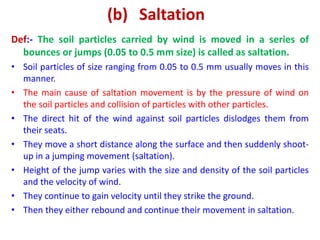This document discusses wind erosion, including its causes, impact areas, and mechanics. It begins by defining wind erosion as the detachment, transportation, and deposition of soil particles by wind. Key factors that influence wind erosion are dry, loose soil; a bare soil surface; and strong winds. Problem areas include coastal regions, deserts, semi-arid areas, and inland river banks. The mechanics of wind erosion involve three phases: initiation of soil movement through suspension, saltation, or surface creep; transportation; and deposition.













